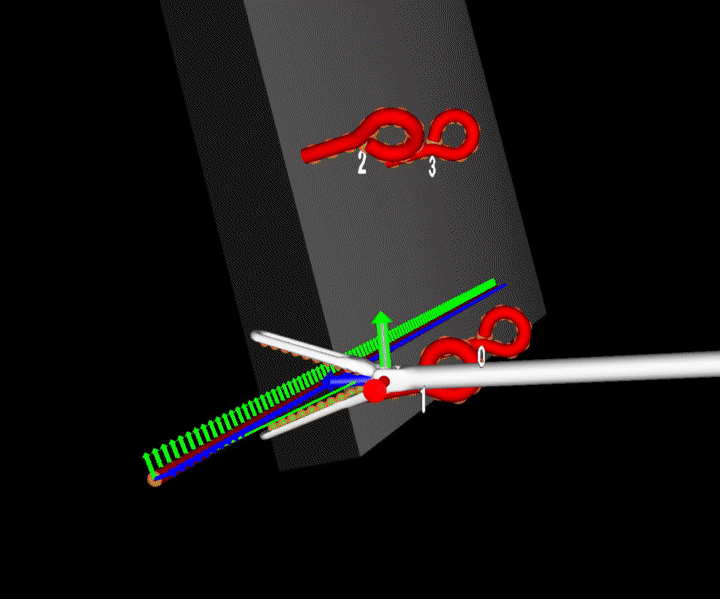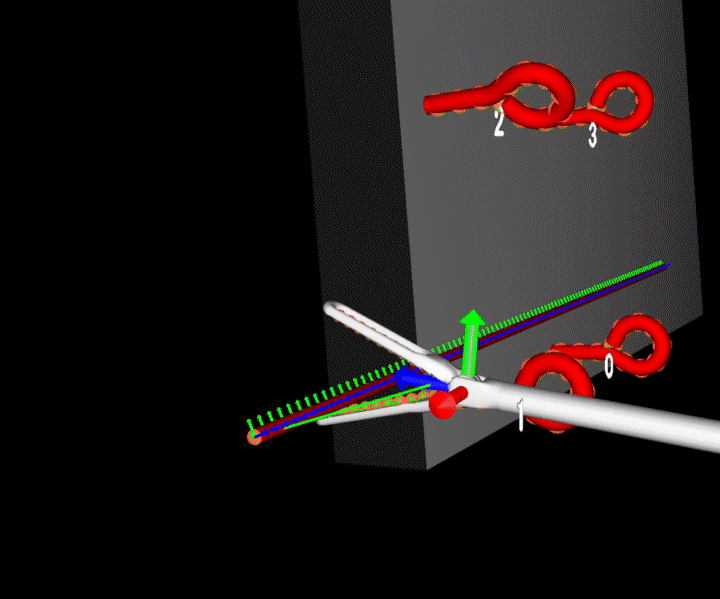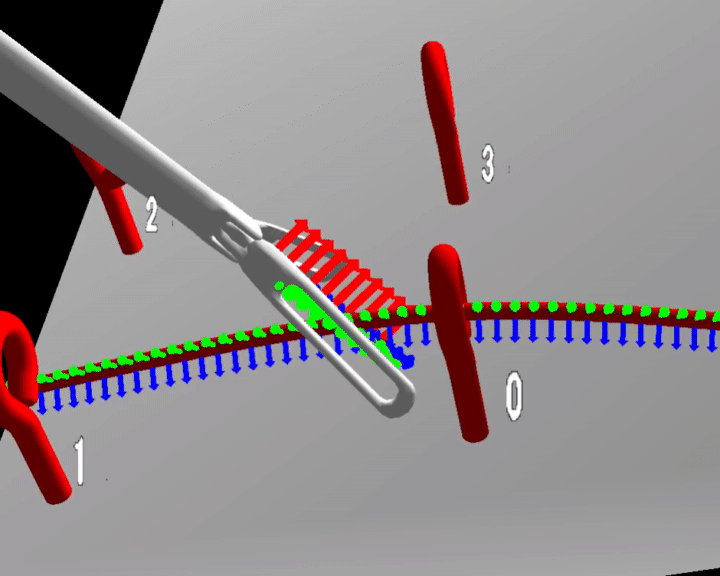Rope Grasping Implementation
Explanation
A rope in sofa_env is modeled as a series of Rigid3d frames that are connected through a BeamFEMForceField.
This means, that every point on the rope has a position, plus an orientation.
Grasping a rope is done by intruducing springs between points on the rope, and points on the gripper.
If these springs just account for the position of the rope, the rope will not follow the gripper realistically.
For example for rotating the gripper:

If the springs account for position and orientation, and we just use the original orientation of the gripper, the orientation will just snap to the one of the gripper. Grasping a bent rope will lead to very wrong behavior, because the rope will always snap to a 90 degree angle in relation to the gripper.

Our implementation accounts for that by updating the position and orientation of the reference points for grasping on the gripper separately. The position is just updated through the absolute position of the gripper. The orientation, however, is calculated based on the absolute orientation of the gripper, and a rotational offset. In the beginning, this rotational offset is zero, but on grasping, the offset is set to the currently measured orientational difference between rope and gripper. This way, if we change the orientation of the gripper in consecutive steps, the added offset will hold the rope in the relative orientation it first had during grasping.

Relevant Code
In the SOFA scene graph, we add a two MechanicalObject to the gripper. A Vec3d that is RigidMapping to the motion_target_mechanical_object and thus follows the gripper.
The second one is a Rigid3d and is not mapped to any other node.
self.grasping_node = self.gripper_node.addChild("grasping")
# A reference object that has as many points as points as there are collisions models, and is mapped to the motion target
motion_reference_node = self.grasping_node.addChild("motion_reference")
self.motion_mapping_mechanical_object = motion_reference_node.addObject(
"MechanicalObject",
template="Vec3d",
position=[position for position in collision_spheres_config["positions"]],
showObject=show_object,
showObjectScale=show_object_scale / 2,
)
motion_reference_node.addObject("RigidMapping", input=self.physical_shaft_mechanical_object.getLinkPath())
# The MechanicalObject that is used for grasping by introducing springs. No mapping, because position and orientation are set in onAnimateBeginEvent
self.grasping_mechanical_object = self.grasping_node.addObject(
"MechanicalObject",
template="Rigid3d",
position=[append_orientation(position) for position in collision_spheres_config["positions"]],
showObject=show_object,
showObjectScale=show_object_scale / 2,
)
At the beginning of each simulation step, the Rigid3d model is updated with positions from the Vec3d model.
The orientation is first taken from the motion_target_mechanical_object and then further rotated with a saved orientation_delta.
This way there is a constant difference in orientation between the Rigid3d model, and the gripper’s motion_target_mechanical_object.
with self.grasping_mechanical_object.position.writeable() as grasping_frames:
grasping_frames[:, :3] = self.motion_mapping_mechanical_object.position.array()
grasping_frames[:, 3:] = multiply_quaternions(
self.motion_target_mechanical_object.position.array()[0, 3:],
self.orientation_delta,
)
The orientation_delta is calculated when the rope is grasped, based on the difference in orientation between the gripper’s motion_target_mechanical_object and the local orientation of the rope, saved in point_orientation.
self.orientation_delta[:] = multiply_quaternions(
conjugate_quaternion(self.motion_target_mechanical_object.position.array()[0, 3:].copy()),
point_orientation,
)
We further want that the rope’s axis is alinged with the gripper jaws. We thus calculate the orientation difference that contributes to rotating the rope out of alignment with the jaws (the y axis), and then factor out this rotation.
# Find the quaternion, that rotates the transformed (by orientation_delta) y axis into the original y axis.
transformed_y_axis = rotated_y_axis(self.orientation_delta)
original_y_axis = np.array([0.0, 1.0, 0.0])
if not np.allclose(transformed_y_axis, original_y_axis):
rotation_into_local_y_axis = quaternion_from_vectors(transformed_y_axis, original_y_axis)
# Add this rotation to the orientation_delta to "undo" the part of the original orientation_delta that rotates
# the y axis out of alignment -> orientation_delta will now only rotate around y of the gripper jaws
self.orientation_delta[:] = multiply_quaternions(
rotation_into_local_y_axis,
self.orientation_delta,
)
The attachment between gripper and rope is then implemented as a RestShapeSpringsForceField between the Rigid3d model and the rope.
The stiffness parameter controls the spring stiffness for translational differences, while angularStiffness controls spring stiffness for orientation differences.
self.grasping_force_field = self.rope.node.addObject(
"RestShapeSpringsForceField",
name=f"grasping_force_field_{name}",
external_rest_shape=self.grasping_mechanical_object.getLinkPath(),
stiffness=self.spring_stiffness_grasping,
angularStiffness=self.angular_spring_stiffness_grasping,
points=grasp_index_pair[1],
external_points=grasp_index_pair[0],
)